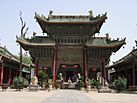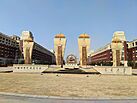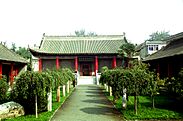Xianyang facts for kids
Quick facts for kids
Xianyang
咸阳市
|
|
|---|---|
|
Prefecture-level city
|
|
|
Maoling Mausoleum
Qianling Mausoleum
Chenghuang Temple
Iharbour Campus of Xi'an Jiaotong University
Xianyang Museum
Fenghuangtai
|
|
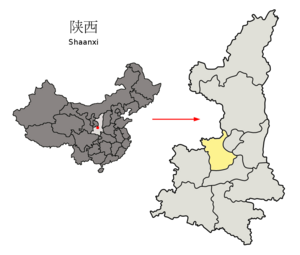
Location of Xianyang Prefecture within Shaanxi
|
|
| Country | People's Republic of China |
| Province | Shaanxi |
| Municipal seat | Qindu District |
| Area | |
| • Prefecture-level city | 10,213 km2 (3,943 sq mi) |
| • Urban | 523 km2 (202 sq mi) |
| Population
(2010)
|
|
| • Prefecture-level city | 5,096,001 |
| • Density | 498.972/km2 (1,292.33/sq mi) |
| • Urban | 945,420 |
| • Urban density | 1,807.7/km2 (4,682/sq mi) |
| • Metro | Xian |
| GDP | |
| • Prefecture-level city | CN¥ 215 billion US$ 34.6 billion |
| • Per capita | CN¥ 43,365 US$6,963 |
| Time zone | UTC+8 (China Standard) |
| ISO 3166 code | CN-SN-04 |
| Xianyang | |||||||||||
|---|---|---|---|---|---|---|---|---|---|---|---|

"Xianyang" in Simplified (top) and Traditional (bottom) Chinese characters
|
|||||||||||
| Simplified Chinese | 咸阳 | ||||||||||
| Traditional Chinese | 咸陽 | ||||||||||
| Postal | Sienyang | ||||||||||
|
|||||||||||
Xianyang (Chinese: 咸阳; pinyin: Xiányáng) is a large city in central Shaanxi province, China. It sits on the Wei River, a short distance west of Xi'an, the provincial capital. Xianyang was once the capital city of the powerful Qin dynasty. Today, it's part of the bigger Xi'an city area, which has over 7 million people. The city itself has a population of about 945,420 people in its main urban areas (Qindu and Weicheng districts), based on the 2010 census. Xianyang covers a total area of about 10,213 square kilometers (3,943 square miles).
Xianyang is home to the Xi'an Xianyang International Airport. This is the main airport for Xi'an and the biggest airport in Northwest China. It's also one of the busiest airports in the world!
The city is also known for its scientific research. It's one of the top 500 cities globally for scientific discoveries, according to the Nature Index. Xianyang has the main campus of Northwest A&F University (NWAFU). This university is famous worldwide for its studies in agriculture. It's also part of a special group called "Project 985," which includes 39 top universities in China.
Contents
A Glimpse into Xianyang's Past
Xianyang has a very long and interesting history. It was an important place during the Western Zhou dynasty. In 350 BC, it became the capital city for the state of Qin during the Warring States period. Later, it became the capital of all of China when the short-lived Qin dynasty began.
The city got its name, "Xianyang," because of its location. It was south of the Jiuzong Mountains and north of the Wei River. Both these directions were considered "sunlight-rich" or yang in ancient Chinese beliefs. So, "Xianyang" means "fully yang."
Xianyang as the Qin Capital
Under the rule of Duke Xiao of Qin, a smart minister named Shang Yang helped design Xianyang. In 350 BC, the Qin government moved its capital from Yueyang to the new city of Xianyang. It remained the capital for over 140 years. Xianyang was built on the north side of the Wei River. Later, on the opposite side of the river, Liu Bang would build the Han dynasty capital, Chang'an.
In 221 BC, Qin Shi Huang became the first emperor of a united China. He defeated the other six warring states and created the Qin dynasty. Xianyang became the most important city for politics, money, and culture in the Qin Empire. The emperor made all the rich and powerful families move to Xianyang. He also gathered all the weapons from across the land. These weapons were melted down and turned into twelve huge statues.
Qin Shi Huang also built a very grand mausoleum (a large tomb) for himself near the capital. This tomb included his famous Terracotta Army. Building this tomb and other big projects took a lot of people and resources away from farming. This, along with strict rules for the people, eventually led to the end of the Qin dynasty and the original city of Xianyang.
Expanding the City and Its Downfall
Emperor Qin Shi Huang made Xianyang much bigger than its original walls. He even built copies of the palaces from all the states he had conquered along the Wei River. In 220 BC, he built a new palace called Xin Palace, later renamed Wei Palace after the Wei River. He continued to build, creating a network of 300 palaces in the Wei valley, connected by special elevated roads. In 212 BC, he started building the huge Epang Palace.
After the First Emperor died in 210 BC, people started to rebel. In December 207 BC, the last Qin emperor, Ziying, gave up to a rebel leader named Liu Bang. Liu Bang entered Xianyang peacefully. However, Liu Bang had to give the city to another, more aggressive rebel leader, Xiang Yu. Xiang Yu's army was much larger. Xiang Yu then killed Ziying and burned Xianyang in 206 BC. This fire destroyed many important books kept in the royal library.
In 202 BC, Liu Bang defeated Xiang Yu. He then became the emperor of the new Han dynasty. He built a new capital city called Chang'an across the Wei River, not far from the ruins of old Xianyang. The Han-era town of Anling was also nearby. It holds some of the Han dynasty's royal tombs.
Discovering Ancient Xianyang
From the late 1950s to the mid-1990s, archaeologists found and dug up many ancient Qin sites in Xianyang. These included old palaces, workshops, and tombs. These discoveries help us learn more about this important historical city.
Xianyang's Divisions
Xianyang is divided into different areas, including districts and counties. You can see these areas on the map below.
| Map | |||||
|---|---|---|---|---|---|
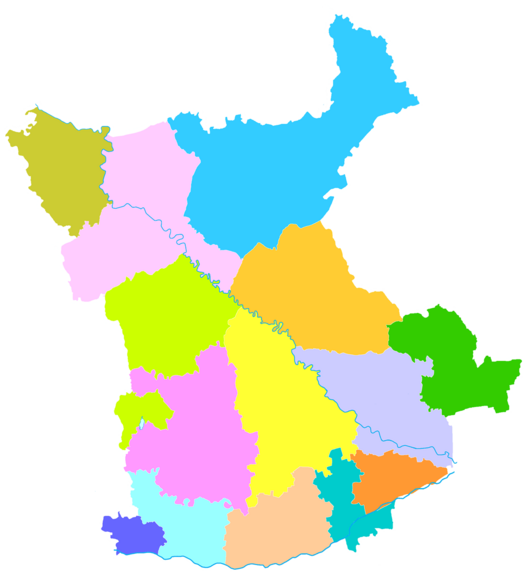
Qindu
Yangling
Weicheng
Sanyuan
County Jingyang
County Qian
County Liquan
County Yongshou
County Changwu
County Xunyi
County Chunhua
County Wugong
County Xingping
(city) Binzhou
(city) |
Xianyang's Weather
Xianyang has a climate with clear seasons. Summers are hot, and winters are cold. The city gets most of its rain in the late summer and early autumn.
| Climate data for Xianyang (Qindu District, 1991–2020 normals, extremes 1981–2010) | |||||||||||||
|---|---|---|---|---|---|---|---|---|---|---|---|---|---|
| Month | Jan | Feb | Mar | Apr | May | Jun | Jul | Aug | Sep | Oct | Nov | Dec | Year |
| Record high °C (°F) | 16.0 (60.8) |
23.0 (73.4) |
30.6 (87.1) |
34.6 (94.3) |
37.8 (100.0) |
41.7 (107.1) |
39.6 (103.3) |
39.2 (102.6) |
36.8 (98.2) |
31.1 (88.0) |
24.4 (75.9) |
22.4 (72.3) |
41.7 (107.1) |
| Mean daily maximum °C (°F) | 4.7 (40.5) |
9.1 (48.4) |
15.1 (59.2) |
21.5 (70.7) |
26.4 (79.5) |
31.5 (88.7) |
32.5 (90.5) |
30.2 (86.4) |
25.1 (77.2) |
19.1 (66.4) |
12.3 (54.1) |
6.3 (43.3) |
19.5 (67.1) |
| Daily mean °C (°F) | −0.9 (30.4) |
2.6 (36.7) |
7.7 (45.9) |
14.1 (57.4) |
19.3 (66.7) |
24.5 (76.1) |
26.3 (79.3) |
24.4 (75.9) |
19.6 (67.3) |
13.3 (55.9) |
6.0 (42.8) |
0.5 (32.9) |
13.1 (55.6) |
| Mean daily minimum °C (°F) | −5.1 (22.8) |
−1.6 (29.1) |
3.4 (38.1) |
8.6 (47.5) |
13.4 (56.1) |
18.8 (65.8) |
22.1 (71.8) |
20.9 (69.6) |
15.9 (60.6) |
9.2 (48.6) |
1.9 (35.4) |
−3.7 (25.3) |
8.7 (47.6) |
| Record low °C (°F) | −16.3 (2.7) |
−12.4 (9.7) |
−8.5 (16.7) |
−2.1 (28.2) |
2.4 (36.3) |
8.7 (47.7) |
14.7 (58.5) |
12.0 (53.6) |
5.0 (41.0) |
−4.4 (24.1) |
−12.3 (9.9) |
−18.6 (−1.5) |
−18.6 (−1.5) |
| Average precipitation mm (inches) | 6.2 (0.24) |
8.8 (0.35) |
22.1 (0.87) |
34.6 (1.36) |
49.8 (1.96) |
60.5 (2.38) |
82.8 (3.26) |
84.6 (3.33) |
89.4 (3.52) |
54 (2.1) |
21.9 (0.86) |
4.5 (0.18) |
519.2 (20.41) |
| Average precipitation days (≥ 0.1 mm) | 3.5 | 3.9 | 5.9 | 7 | 8.8 | 8 | 9.7 | 9.4 | 11.4 | 9.6 | 5.7 | 2.8 | 85.7 |
| Average snowy days | 4.3 | 3.1 | 1.3 | 0.1 | 0 | 0 | 0 | 0 | 0 | 0 | 1.2 | 2.6 | 12.6 |
| Average relative humidity (%) | 64 | 63 | 62 | 66 | 65 | 61 | 69 | 75 | 78 | 78 | 74 | 66 | 68 |
| Mean monthly sunshine hours | 134.4 | 132 | 169.8 | 194.4 | 211.3 | 211 | 223.2 | 200.8 | 143.1 | 138 | 135.5 | 141 | 2,034.5 |
| Percent possible sunshine | 43 | 42 | 46 | 49 | 49 | 49 | 51 | 49 | 39 | 40 | 44 | 46 | 46 |
| Source: China Meteorological Administration | |||||||||||||
Learning and Education
Xianyang is an important center for learning. It has several universities and colleges.
- Northwest A&F University (NWAFU): This is a top university, especially for agriculture. It's part of a special group of 39 highly respected universities in China.
- Shaanxi University of Science & Technology
- Shaanxi University of Chinese Medicine
- Xianyang Normal University
Getting Around Xianyang
Xianyang has good transportation links, making it easy to travel to and from the city.
- China National Highway 312: A major road connecting different parts of China.
- Xi'an Xianyang International Airport: The main airport for the region, serving many flights.
- Xianyang West railway station: A train station for passenger services.
- Xi'an Metro Line 1: A subway line that connects Xianyang to the larger Xi'an metropolitan area.




